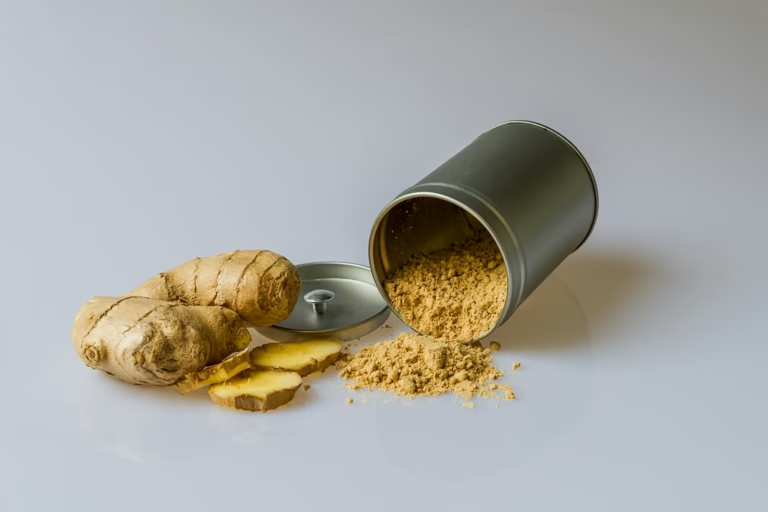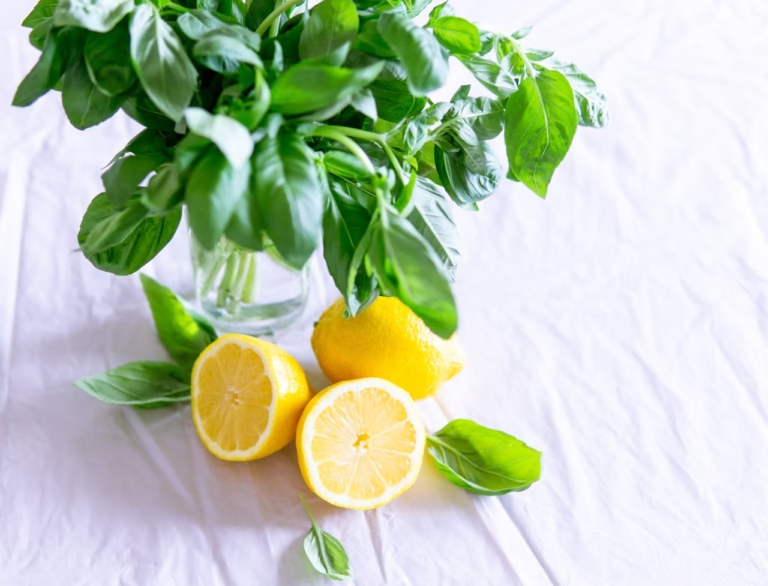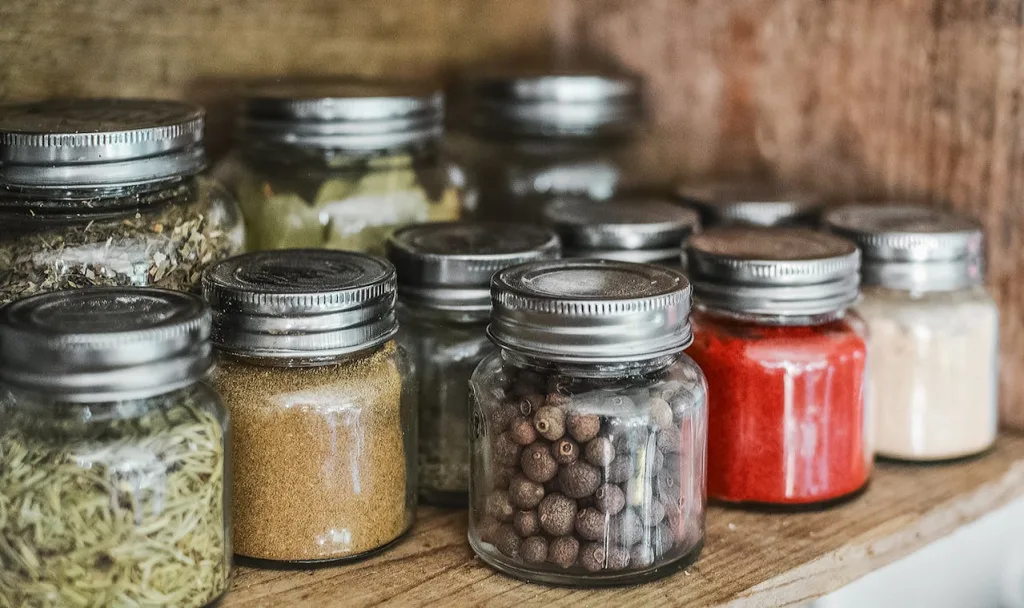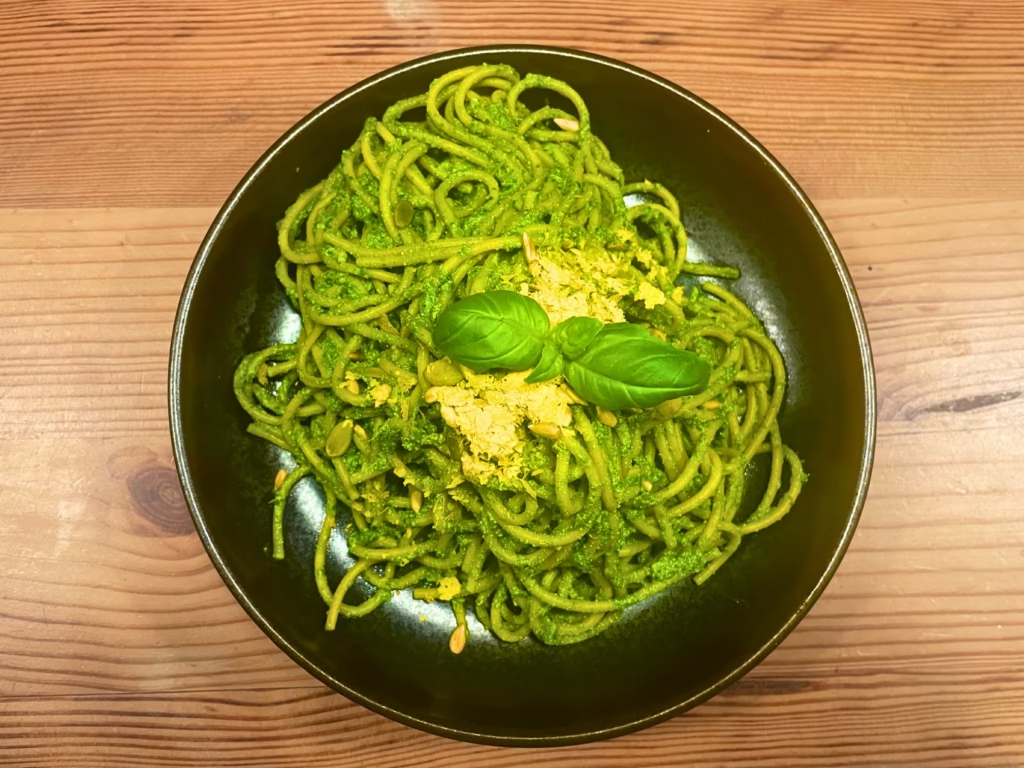Spices and herbs are an inexpensive, low-calorie way to add flavour and antioxidants to every dish.
As spices and herbs are used daily, I recommend using pure, high-quality, Certified Organic spices and herbs to increase the health benefits and avoid additives like fillers, artificial flavours, or preservatives. If you use Asian spices, try to find the ones that are tested for heavy metals.
I have created a list of healthy spices and herbs to help you choose the best quality and type. I have shared some tips on increasing the health benefits of spices and herbs and added a few suggestions on using spices and herbs for cooking.
The top 10 Healthy Spices list that you will always find in my kitchen are Turmeric, Ginger, Garlic, Chili, Cinnamon, Rosemary, Oregano, Basil, Parsley, and Cocoa.
Here is a tick list of the top 10 Healthy Spices and Herbs and their benefits:
| Spice | Anti-inflammatory | Antioxidant | Improves Digestion | Cardiovascular Health | Antimicrobial | Anti-diabetic | Cognitive Benefits | Reduces Nausea | Dental Health | Bone Health | Skin Health |
|---|---|---|---|---|---|---|---|---|---|---|---|
| Turmeric | ✓ | ✓ | ✓ | ✓ | ✓ | ✓ | |||||
| Ginger | ✓ | ✓ | ✓ | ✓ | ✓ | ✓ | ✓ | ✓ | |||
| Garlic | ✓ | ✓ | ✓ | ✓ | ✓ | ✓ | |||||
| Chili | ✓ | ✓ | ✓ | ✓ | ✓ | ||||||
| Cinnamon | ✓ | ✓ | ✓ | ✓ | |||||||
| Rosemary | ✓ | ✓ | ✓ | ✓ | |||||||
| Oregano | ✓ | ✓ | ✓ | ||||||||
| Basil | ✓ | ✓ | ✓ | ||||||||
| Parsley | ✓ | ✓ | ✓ | ✓ | |||||||
| Cocoa | ✓ | ✓ | ✓ | ✓ | ✓ | ✓ |
We are starting the healthy spices list with:
1. Turmeric
The Best Kind: Use pure, raw turmeric powder with a high curcumin concentration (8% to 12% for cooking varieties; if you take it as a supplement, it will be higher).
Health Benefits: Turmeric is known for its anti-inflammatory and antioxidant properties. It can help manage arthritis pain, heart health, brain function, gut and metabolic health. (1)
Tips:
- To maximise turmeric’s health benefits, combine it with black pepper, which increases curcumin absorption by 2000 per cent! (2)
- Turmeric is fat-soluble; therefore, using the spice with healthy fats will help your body absorb it better.
- Don’t overheat it; try adding turmeric at the end of cooking to preserve most of its nutrition.
Cooking:I love adding turmeric to stews, curries, and chickpea shakshuka. I also sneak it into smoothies with a bit of pepper. Ginger, lemon, and turmeric tea are my go-to hot drinks in cold winter.
Number two on the healthy spices list :

2. Ginger
Best Kind: Use fresh ginger root, which has a higher concentration of gingerol, the compound responsible for ginger’s medicinal properties. When choosing powdered ginger, choose organic, freshly ground ginger from a reputable source.
Health Benefits: Ginger aids in digestive health, reduces nausea, and can help with muscle pain and soreness. It also has anti-inflammatory and antioxidant properties.
Tips:
- To make sure your ginger root doesn’t mould and spoil, keep it in a dry place and avoid moisture.
- Freeze Whole Ginger to make it last for months. Then, grate or slice it directly from the freezer.
- Gentle heating can increase some of ginger’s benefits, but overcooking might kill many nutrients, so add ginger toward the end of the cooking to preserve all the nutrients and potency.
Cooking: For a warming and spicy kick, incorporate fresh ginger into teas, smoothies, stir-fries, and soups.
3. Garlic
Best Kind: Fresh garlic cloves provide the most health benefits compared to powdered or granulated garlic.
Health Benefits: Garlic supports cardiovascular health by reducing blood pressure and cholesterol levels. It also has immune-boosting properties.
Tips:
- If you have a sensitive stomach, use garlic powder rather than fresh garlic. Black garlic is also much gentler on your stomach, it is also softer, and very sweeter in taste.
- Removing the green sprout in the centre of a garlic clove can help reduce ‘garlic breath’ and make it easier to digest.
- Store whole garlic bulbs in a cool, dry place. Avoid plastic bags or sealed containers, which can trap moisture and boost mould growth. Whole garlic bulbs should not be stored in the fridge, as the cold and humidity can reduce their shelf life.
- The health benefits of garlic come primarily from allicin, a compound that forms when garlic is chopped. To maximise the amount of allicin, prepare garlic at least 10-15 minutes before cooking and let it sit on a chopping board.
- Mix garlic with healthy fats, like olive oil, to help increase the absorption of fat-soluble vitamins and compounds.
Cooking: Use minced or whole cloves in sauces, dressings, marinades, or as part of the seasoning. I like sprinkling garlic powder on roast potatoes. My stomach can’t handle raw garlic, so I add black garlic cloves to hummus, giving it a more subtle and sweeter taste.
4. Peppers (chilli pepper, paprika)
Best Kind: Fresh chilli peppers will have the highest levels of vitamins and minerals. But you can still use high-quality, pure chilli powder, smoked or mild paprika without additives as it is so versatile and will last so much longer than fresh papers.
Health Benefits:
Chillies can boost metabolism, help relieve pain, and reduce the risk of heart disease.
Capsaicin in peppers can help with weight loss and prevent weight gain by increasing calorie burning, enhancing fat oxidation, and reducing appetite.
Chilli peppers are rich in antioxidants, like vitamins C and A, flavonoids, and carotenoids, which help fight oxidative stress and reduce inflammation.
Some in vitro trials suggest capsaicin can kill cancer cells and reduce the size of certain cancerous tumours (3)(4).
Chilli peppers can help digestion by increasing digestive fluid production and protecting the stomach against ulcers.
Tips:
- Vitamin C in paper helps absorption of Iron from other plant sources, so add chilli when cooking lentils, greens, and beans.
- Start with small amounts to see how your body reacts, mainly if you’re not used to spicy foods.
- There are many chilli peppers, each with its flavour profile, heat level, and nutritional benefits, so experiment and find the ones you like the most.
Cooking: Add to soups, stews, sauces, or marinades for a spicy heat. I add multiple kinds of peppers to so many dishes, from shakshuka and baked beans to soups, and even sprinkle a tiny bit in smoothies or salads.
5. Cinnamon
Best Kind: choose Ceylon cinnamon over Cassia cinnamon. Ceylon cinnamon is lower in coumarin, a compound that can be harmful in large amounts.
Health Benefits: Cinnamon can lower blood sugar levels, reduce heart disease risk factors, and has anti-inflammatory properties(5) control blood pressure, tumour growth, diabetes, Alzheimer’s and Parkinson’s diseases (6)
Tips:
- Use it to sweeten coffee, tea, or whole-grain toast to lower your sugar intake while benefiting from its blood sugar-regulating effects.
- I would avoid cinnamon supplements as they can contain concentrated amounts of compounds, making it easier to exceed safe consumption levels.
Cooking: Sprinkle over oatmeal or popcorn, blend into smoothies, or add to your baking for a sweet and warming flavour.
Make cinnamon tea. Soak a cinnamon stick in boiling water or add ground cinnamon to herbal teas for a warm, antioxidant-rich drink. My favourite snack is popcorn with cinnamon and some organic, unrefined sugar.

Cooking: Rosemary is excellent with roast potatoes and bread. It is a member of the mint family, and I love making rosemary tea with lemon. I also add ginger, cinnamon, or whole cloves to the pot and simmer them together- so delicious and good for you.
6. Rosemary
Best Kind: Fresh rosemary offers a stronger smell and flavour, though dried rosemary is a convenient alternative that will last a very long time.
Health Benefits: Rosemary can improve digestion, enhance memory and concentration (7), and provide antioxidant and anti-inflammatory compounds.
Tips:
- Rosemary is very easy to grow. Buy it in the pot; it will always be fresh and will last for a long time.
- Rosemary can be used in aromatherapy to improve concentration, reduce stress, and boost mood.
- Rosemary helps reduce the formation of Carcinogens when cooking meats at high temperatures. So, if you eat meat, sprinkle lots of rosemary on it (8).
7. Oregano
Best Kind: Fresh oregano contains more vitamin C, but dried oregano is more concentrated in antioxidants like thymol and carvacrol, so use both.
Health Benefits: oregano is rich in antioxidants, which help fight free radicals in the body. It’s also a good source of fibre, vitamin K, manganese, iron, calcium, vitamin E, and tryptophan. Oregano contains flavonoids and phenolic compounds that have potential antioxidant, anti-inflammatory and anti-cancer health benefits. (9)
Tips:
- Dried herbs are more potent, so you’ll need less dried oregano than fresh to achieve the same flavour intensity, so don’t overdo it when using it dried.
- Oregano contains fat-soluble compounds, which are better absorbed when consumed with healthy fats.
- Adding oregano at the end of the cooking process will help preserve its essential oils and antioxidants.
Cooking: Dried oregano is perfect in Italian and Mexican dishes. Sprinkle it over pizzas and pasta or into marinades and salads.

8. Basil
Best Kind: Fresh basil leaves provide a vibrant flavour.
Health Benefits: Basil offers anti-inflammatory and antibacterial benefits, along with a high dose of antioxidants.
Tips:
- There are over 60 varieties of basil, ranging from sweet to spicy and even lemony, so shop around and experiment and see what is your favourite.
- Not a cooking tip, but still wanted to share it- basil is an effective natural insect repellent, particularly against mosquitoes and flies.
- Keep basil in the fridge, wrapped in a slightly damp paper towel and placed in a plastic bag or a glass of water; cover the leaves with a plastic bag to keep it fresh for a very long time.
Cooking: Basil is a staple in Italian cuisine; use it in pesto, salads, or as a fresh topping on dishes. Basil also goes very well with fruits like berries, peaches, and citrus, creating nutritious smoothie combinations or just a very fresh summer fruit salad.
9. Parsley
Best Kind: Fresh flat-leaf parsley has a more intense flavour than the curly variety and is richer in nutrients.
Health Benefits: Parsley is an excellent Vitamin K source, essential for bone health. It also contains Vitamin C, Vitamin A, and iron, which support immune function and eye health. It is rich in Antioxidants and has Anti-inflammatory properties. Parsley acts as a natural diuretic, helping to flush out toxins from the body through the kidneys and potentially preventing kidney stones (10).
Tips:
- Chewing fresh parsley can help reduce bad breath, thanks to its high chlorophyll content.
- Like all herbs, keep parsley in the fridge in a glass of water; cover the leaves with a plastic bag.
- If you are not a big fan of the flavour, use curly-leaf parsley for a more subtle taste.
Cooking: Parsley can be used in salads, stews, soups, and sauces, or as a garnish to add freshness. I like to blend some parsley in pesto or add some to homemade hummus.
The last but definitely not the least on the healthy spices list is :

10. Cocoa
Best Kind: Raw, natural, or ‘unmatched’ cocoa powder or dark chocolate with a high cocoa content (70% or higher) provides the most health benefits.
Health Benefits: Cocoa, rich in antioxidants and flavonoids, offers many health benefits, including improved heart health through better blood flow and lower blood pressure, improved cognitive function, mood elevation, and anti-inflammatory effects. Its compounds may also protect against sun-induced skin damage, support diabetes management by improving insulin sensitivity, and potentially protect from cancer. Theobromine in cocoa can strengthen tooth enamel, contributing to better dental health.(11)(12)
Tips:
- Pair cocoa with nuts. The healthy fats in nuts can increase the absorption of cocoa’s antioxidants. Both cocoa and nuts are high in calories, so enjoy them in moderation ( try to have one small piece rather than the slab of chocolate).
- Add Cocoa powder to savoury dishes like chilli, mole sauces, or stews to deepen the flavour profile and add an extra dose of antioxidants.
- Cocoa contains caffeine and theobromine, both of which can dehydrate you. So make sure you drink plenty of water or tea with your chocolate.
Cooking: Add cocoa powder or cocoa nibs to smoothies, oatmeal, fruit bowls or homemade healthy desserts.
What Herbs And Spices Are Good for Dogs?
Herbs and spices can also benefit our four-legged friends, although we need to be more careful about what and how much we give them.
I have created a table with all spices and herbs that are safe a nd benefisial for dogs :
| 🧂 Dog-Safe Spices | Benefits | How to Use |
|---|---|---|
| Turmeric | Anti-inflammatory, antioxidant, supports joint health | Mix a small pinch with fat (e.g., coconut oil) and black pepper for absorption |
| Ginger | Eases nausea, improves digestion, anti-inflammatory | Use fresh grated or dried powder, in tiny amounts mixed into food |
| Cinnamon (Ceylon only) | Regulates blood sugar, anti-inflammatory, may improve brain function | Use a sprinkle occasionally; avoid cassia cinnamon, which can be toxic |
| 🌿 Dog-Safe Herbs | ||
| Parsley (flat-leaf only) | Freshens breath, rich in vitamins A, C, and K | Use fresh, chopped finely; avoid curly parsley and limit amount |
| Basil | Calming, antioxidant, anti-inflammatory | Add a few chopped leaves to meals |
| Cilantro | Aids digestion, detoxifying, rich in vitamins | Mix fresh chopped leaves into food |
| Rosemary | Antioxidant, supports brain health, antimicrobial | Use very sparingly; avoid in dogs with seizure history |
| Thyme | Antimicrobial, supports respiratory health | Add a small pinch of dried or fresh thyme |
| Oregano | Antibacterial, antifungal, immune support | Use lightly dried or fresh; avoid oregano oil unless vet-approved |
| Dill | Aids digestion, freshens breath | Use fresh chopped leaves in small quantities |
| Mint (common mint only) | Eases digestion, freshens breath | Add a few chopped leaves; avoid pennyroyal mint which is toxic |
When introducing spices and herbs in your dog’s diet, make sure to start slow and watch for any allergic reactions or stomach upset. If you are feeding a good quality kibble, the spices and herbs can already be included in your dog’s food, so read the label before adding more the herbs.
⚠️ Herbs and Spices to AVOID for Dogs
Garlic (including garlic powder) is toxic to dogs.
Onion, chives, and leeks are all highly toxic.
Nutmeg can cause hallucinations and toxicity.
Salt-heavy or spicy blends may upset the stomach or be toxic.
Paprika, chili powder are irritants to dogs’ stomachs and eyes.
To summarise the healthy spices and herbs list:
Adding various healthy spices and herbs is the easiest and cheapest way to make our cooking more nutritious. Ensure you always stock up on these top 10 Healthy Spices and Herbs for Cooking. What are your most-used healthy herbs and spices? Do you have your own healthy spices list? Leave a comment below.
Read 20 AFFORDABLE SUPERFOODS & THEIR SCIENCE-PROVED BENEFITS for more nutritious food suggestions.
Updated on 09/06/2025 by Silvija Meilunaite
- Tayyem RF, Heath DD, Al-Delaimy WK, Rock CL. Curcumin content of turmeric and curry powders. Nutr Cancer. 2006;55(2):126-31. doi: 10.1207/s15327914nc5502_2. PMID: 17044766. https://pubmed.ncbi.nlm.nih.gov/17044766/ . Okamoto, Shawna MD; Morris, Carl MD, MPH. Is turmeric efficacious in treating osteoarthritic knee joint pain in adult patients? Evidence-Based Practice 24(7):p 19-20, July 2021. | DOI: 10.1097/EBP.0000000000001088 https://journals.lww.com/ebp/citation/2021/07000/is_turmeric_efficacious_in_treating_osteoarthritic.15.aspx
- https://www.webmd.com/diet/supplement-guide-turmeric
- Akio Mori, Sören Lehmann, James O’Kelly, Takashi Kumagai, Julian C. Desmond, Milena Pervan, William H. McBride, Masahiro Kizaki, H. Phillip Koeffler; Capsaicin, a Component of Red Peppers, Inhibits the Growth of Androgen-Independent, p53 Mutant Prostate Cancer Cells. Cancer Res 15 March 2006; 66 (6): 3222–3229. https://doi.org/10.1158/0008-5472.CAN-05-0087
- Thoennissen, N., O’Kelly, J., Lu, D. et al. Capsaicin causes cell-cycle arrest and apoptosis in ER-positive and –negative breast cancer cells by modulating the EGFR/HER-2 pathway. Oncogene 29, 285–296 (2010). https://doi.org/10.1038/onc.2009.335
- Cinnamon and Health https://www.tandfonline.com/doi/abs/10.1080/10408390902773052
- Revisiting an ancient spice with medicinal purposes: Cinnamon https://www.sciencedirect.com/science/article/abs/pii/S0924224416304782?via%3Dihub.
- The Effects of Rosemary on Cognitive Function in an Elderly Population https://www.liebertpub.com/doi/10.1089/jmf.2011.0005
- University of Arkansas, Food Safety Consortium. “To Block The Carcinogens, Add A Touch Of Rosemary When Grilling Meats.” ScienceDaily. ScienceDaily, 24 May 2008. <www.sciencedaily.com/releases/2008/05/080521184129.htm>.
- Gutiérrez-Grijalva, E.P.; Picos-Salas, M.A.; Leyva-López, N.; Criollo-Mendoza, M.S.; Vazquez-Olivo, G.; Heredia, J.B. Flavonoids and Phenolic Acids from Oregano: Occurrence, Biological Activity and Health Benefits. Plants 2018, 7, 2. https://doi.org/10.3390/plants7010002
- https://www.sciencedirect.com/science/article/abs/pii/S0378874101004081?via%3Dihub
- Andújar, I., Recio, M., Giner, R., & Ríos, J. (2012). Cocoa Polyphenols and Their Potential Benefits for Human Health. Oxidative Medicine and Cellular Longevity, 2012. https://doi.org/10.1155/2012/906252.
- Kargul, B., Özcan, M., Peker, S., Nakamoto, T., Simmons, W., & Falster, A. (2012). Evaluation of human enamel surfaces treated with theobromine: a pilot study. Oral health & preventive dentistry, 10 3, 275-82.
Silvija Meilunaite, PN1-NC, CSMC, is a certified nutrition and menopause coaching specialist, and a writer in the nutrition and self-improvement field. She explores science-based approaches to holistic health and plant-based nutrition, with a strong focus on researching clean, non-toxic products that support long-term well-being.
- S. Meilunaitehttps://barefootbasil.com/author/silvootegmail-com/
- S. Meilunaitehttps://barefootbasil.com/author/silvootegmail-com/
- S. Meilunaitehttps://barefootbasil.com/author/silvootegmail-com/
- S. Meilunaitehttps://barefootbasil.com/author/silvootegmail-com/




